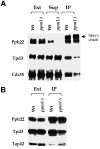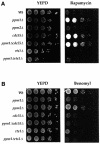Carboxyl methylation of the phosphoprotein phosphatase 2A catalytic subunit promotes its functional association with regulatory subunits in vivo
- PMID: 11060018
- PMCID: PMC305778
- DOI: 10.1093/emboj/19.21.5672
Carboxyl methylation of the phosphoprotein phosphatase 2A catalytic subunit promotes its functional association with regulatory subunits in vivo
Abstract
The phosphoprotein phosphatase 2A (PP2A) catalytic subunit contains a methyl ester on its C-terminus, which in mammalian cells is added by a specific carboxyl methyltransferase and removed by a specific carboxyl methylesterase. We have identified genes in yeast that show significant homology to human carboxyl methyltransferase and methylesterase. Extracts of wild-type yeast cells contain carboxyl methyltransferase activity, while extracts of strains deleted for one of the methyltransferase genes, PPM1, lack all activity. Mutation of PPM1 partially disrupts the PP2A holoenzyme in vivo and ppm1 mutations exhibit synthetic lethality with mutations in genes encoding the B or B' regulatory subunit. Inactivation of PPM1 or overexpression of PPE1, the yeast gene homologous to bovine methylesterase, yields phenotypes similar to those observed after inactivation of either regulatory subunit. These phenotypes can be reversed by overexpression of the B regulatory subunit. These results demonstrate that Ppm1 is the sole PP2A methyltransferase in yeast and that its activity is required for the integrity of the PP2A holoenzyme.
Figures








Similar articles
-
Protein phosphatase methyltransferase 1 (Ppm1p) is the sole activity responsible for modification of the major forms of protein phosphatase 2A in yeast.Arch Biochem Biophys. 2001 Nov 15;395(2):239-45. doi: 10.1006/abbi.2001.2558. Arch Biochem Biophys. 2001. PMID: 11697862
-
Carboxyl methylation regulates phosphoprotein phosphatase 2A by controlling the association of regulatory B subunits.EMBO J. 2000 Nov 1;19(21):5682-91. doi: 10.1093/emboj/19.21.5682. EMBO J. 2000. PMID: 11060019 Free PMC article.
-
Carboxymethylation of the PP2A catalytic subunit in Saccharomyces cerevisiae is required for efficient interaction with the B-type subunits Cdc55p and Rts1p.J Biol Chem. 2001 Jan 12;276(2):1570-7. doi: 10.1074/jbc.M008694200. J Biol Chem. 2001. PMID: 11038366 Free PMC article.
-
Protein phosphatase 2A on track for nutrient-induced signalling in yeast.Mol Microbiol. 2002 Feb;43(4):835-42. doi: 10.1046/j.1365-2958.2002.02786.x. Mol Microbiol. 2002. PMID: 11929536 Review.
-
Effects of carboxyl-terminal methylation on holoenzyme function of the PP2A subfamily.Biochem Soc Trans. 2020 Oct 30;48(5):2015-2027. doi: 10.1042/BST20200177. Biochem Soc Trans. 2020. PMID: 33125487 Free PMC article. Review.
Cited by
-
Restricted protein phosphatase 2A targeting by Merkel cell polyomavirus small T antigen.J Virol. 2015 Apr;89(8):4191-200. doi: 10.1128/JVI.00157-15. Epub 2015 Jan 28. J Virol. 2015. PMID: 25631078 Free PMC article.
-
Direct and Indirect Targeting of PP2A by Conserved Bacterial Type-III Effector Proteins.PLoS Pathog. 2016 May 18;12(5):e1005609. doi: 10.1371/journal.ppat.1005609. eCollection 2016 May. PLoS Pathog. 2016. PMID: 27191168 Free PMC article.
-
Septins: molecular partitioning and the generation of cellular asymmetry.Cell Div. 2009 Aug 26;4:18. doi: 10.1186/1747-1028-4-18. Cell Div. 2009. PMID: 19709431 Free PMC article.
-
Coupling to short linear motifs creates versatile PME-1 activities in PP2A holoenzyme demethylation and inhibition.Elife. 2022 Aug 4;11:e79736. doi: 10.7554/eLife.79736. Elife. 2022. PMID: 35924897 Free PMC article.
-
Determinants for Substrate Specificity of Protein Phosphatase 2A.Enzyme Res. 2011;2011:398751. doi: 10.4061/2011/398751. Epub 2011 Jul 2. Enzyme Res. 2011. PMID: 21755039 Free PMC article.
References
-
- Beck T. and Hall,M.N. (1999) The TOR signalling pathway controls nuclear localization of nutrient-regulated transcription factors. Nature, 402, 689–692. - PubMed
-
- Chelsky D., Ruskin,B. and Koshland,D.E.,Jr (1985) Methyl-esterified proteins in a mammalian cell line. Biochemistry, 24, 6651–6658. - PubMed
-
- Chen J., Martin,B.L. and Brautigan,D.L. (1992) Regulation of protein serine–threonine phosphatase type-2A by tyrosine phosphorylation. Science, 257, 1261–1264. - PubMed
-
- Chen J., Parsons,S. and Brautigan,D.L. (1994) Tyrosine phosphorylation of protein phosphatase 2A in response to growth stimulation and v-src transformation of fibroblasts. J. Biol. Chem., 269, 7957–7962. - PubMed
-
- Chen J., Peterson,R.T. and Schreiber,S.L. (1998) α4 associates with protein phosphatases 2A, 4 and 6. Biochem. Biophys. Res. Commun., 247, 827–832. - PubMed
Publication types
MeSH terms
Substances
Grants and funding
LinkOut - more resources
Full Text Sources
Other Literature Sources
Molecular Biology Databases

